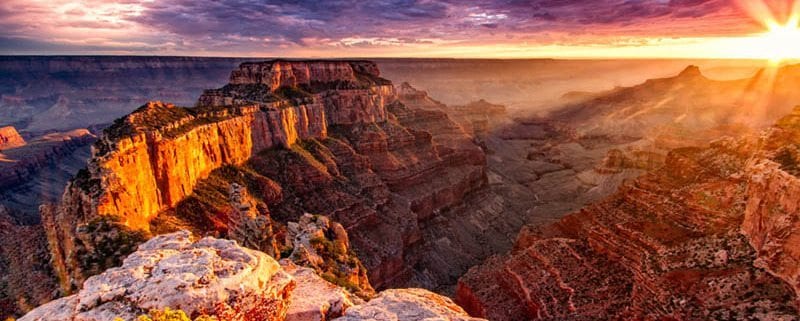Grand Canyon Things to Do | Sightseeing South Rim Taki, Grandview, Moran, Point
The Grand Canyon features a diverse and majestic geological extravaganza. It stretches for 277 miles, measures from four to 18 miles in width, and averages a mile in depth. Covering more than 1.2 million acres, the semi-arid canyon consists of raised plateaus, steep-walled canyons, desert basins at lower elevations and forests at higher elevations. Canyon walls provide wide-ranging fossil specimens, a vast array of geological features and rock types, and numerous caves.
For visitors who are interested in exploring scenic vistas not far from Grand Canyon Village – which is center of activity and the transportation hub of the South Rim – the east rim is an ideal destination.
Here are some must-see locations at the eastern part of the South Rim:
Yaki Point
Below Yaki Point is the longest trail in the canyon, Tonto Trail, which travels the length of the canyon. Pipe Creek is situated on the west side below the point. The creek was given its name as a result of a practical joke around 1890, when hiker Ralph Cameron found a meerschaum pipe in the stream. His friends had not yet reached the creek, so before they arrived Cameron carved an 18th century date on the pipe and put it back into the creek. When his friends found the pipe in the water, they were astonished to see what they thought was a 100-year-old relic.
Grandview Point
Below this point there was a copper ore mine operated on Horseshoe Mesa. A miner named Peter Berry extracted the copper for seven years, but operating the mine in remote desert conditions was not profitable. Tourism was on the rise, and Berry decided that becoming a hotelier would be a more lucrative venture, so he built the Grandview Hotel. Berry closed the hotel and the mine in 1908 after his business experienced a steep decline due to the railroad’s arrival at Grand Canyon Village. The Grandview Trailhead is located at Grandview Point.
Moran Point
It is believed that this point was named after Thomas Moran, a 19th century American landscape painter and a member of Major John Wesley Powell’s Grand Canyon expedition in 1871. Through his artwork, Moran swayed Congress to increase public awareness of the canyon and preserve the land. On the west side of Moran Point is Hance Canyon. In 1883, Captain John Hance became the first European American to make his home at the Grand Canyon. A former miner, he discovered that leading guided tours was more profitable.
Tusayan Museum and Ruins
Excavated by Emile W. Haury in 1930, the Tusayan Museum and Ruins is a site where visitors can envision prehistoric life in the Grand Canyon. Historians believe this is where the Anasazi Indians lived in a tiny pueblo around 1185 A.D. Guided tours are hosted daily around the ruins and garden area by park rangers.
Lipan Point
North of Lipan Point is Seventy-Five-Mile Creek, which empties into the Colorado River. The point is also home to Tanner Trailhead, which leads nine miles into the canyon to the mouth of the Unkar Creek. Here, hikers will find Anasazi ruins that are more than 1,000 years old.
Desert View
Desert View is distinctly marked by a tall watch tower built in 1932. The structure was designed by renowned architect Mary Jane Colter to re-create a prehistoric American structure. Inside the tower are murals painted by Hopi artist, Fred Kabotie.
To learn more about the Grand Canyon itself, make plans to see the Visitor Center (www.explorethecanyon.com), which is located at the south rim entrance of Grand Canyon National Park. The visitor center serves as a destination and a resource for the most comprehensive selection of information about Grand Canyon area hotels, tours, attractions, restaurants and sightseeing and outdoor activities.
The Visitor Center features a 500-seat IMAX Theater which shows “Grand Canyon: Rivers of Time,” a 2,500-square-foot outfitter store, exhibits and maps, and national park interpretive services and park passes. The facility also includes a 140-seat restaurant, Expeditions sightseeing tours and the Arizona Office of Tourism.
Grand Canyon: Rivers of Time is a perfect way to begin your Grand Canyon vacation because the film introduces viewers to the natural wonders and riveting history that lies within the canyon. The movie is shown hourly, 365 days a year. Seen by more than 40 million people since its debut 20 years ago, Grand Canyon is the highest-grossing giant-screen film of all time.




